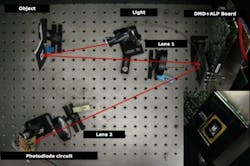Compressive sensing gets patented
Researchers at Rice University (Houston, TX, USA) have been granted a US patent for their work developing a camera based on compressive sensing.
The patent granted to Rice describes the basic architecture and design of such a compressive sensing camera, which uses a spatial light modulator, a single or small number of detector diodes, an analog-to-digital convertor and an algorithm to reconstruct images from the detectors.
To commercialize the technology, InView Technology (Austin, TX, USA) has obtained an exclusive license from Rice University, and now plans to apply the patent to the development of imaging cameras that can operate in the ultraviolet, visiblel, infrared, and terahertz frequency ranges.
Headed up by Rice University professor Richard Baraniuk, InView will initially deploy the technology in a family of shortwave infrared cameras that are suited for security, surveillance and maritime navigation applications because of their unique ability to see through impairments such as fog, haze, smoke and dust. (You can read an article by a team involving Rice University, University of Mexico, and InView published by Laser Focus Worldhere.)
As the field of compressive sensing is relatively recent, there are very few good introductions to the subject on the internet. However, one very useful explanation by UCLA professor of mathematics Terence Tao can be found here.
Details of the Rice patent "Method and apparatus for compressive imaging device" can be found here.
-- by Dave Wilson, Senior Editor, Vision Systems Design
